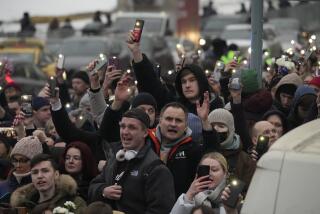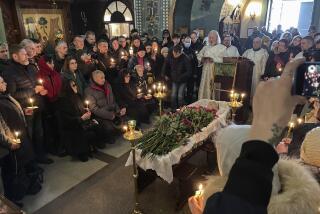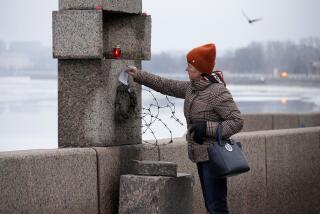It’s Bolshevik Vs. Czar Again in Fight Over Remains of Lenin, Nicholas II
- Share via
MOSCOW — The corpse of one lies mummified in a glass case on display in the center of Moscow. The bones of the other rest on a shelf in the distant Yekaterinburg morgue.
Long dead but not buried, these rivals of the past--Communist leader Vladimir I. Lenin and Czar Nicholas II--have taken on new life as symbols in the contest to control Russia’s future.
President Boris N. Yeltsin, who touched off a furor earlier this year when he proposed moving Lenin’s mummified body from its Red Square mausoleum, now says he will call a referendum this fall to decide what is to be done with the pickled dictator.
“Lenin should be buried in the earth,” Yeltsin said during a trip to St. Petersburg last week. “Red Square must not resemble a cemetery. Certainly, Communists will vigorously oppose this action, but I am used to having disputes with them.”
Yeltsin’s plan to move Lenin’s mummy--and the remains of more than 400 other Soviet heroes buried nearby--is another sign that the Communists who ruled the country for 75 years continue to fade in power following their 1996 presidential election defeat.
The debate turned ugly earlier this year when Moscow’s lone monument to Czar Nicholas, a statue on the outskirts of the city, was blown up. An obscure Communist group claimed responsibility, saying it was in retaliation for the proposal to move Lenin’s corpse.
Communist members of the Duma, the lower house of parliament, have mounted a campaign to preserve the shrine to Lenin in Red Square, the historic plaza next to the Kremlin. The chief of one hard-line faction pledged to stand outside the mausoleum and shoot anyone who tried to take away the revolutionary leader’s body.
Doctors who faithfully keep Lenin looking as fresh as possible with the liberal use of chemicals protest that the accomplishment of preserving the body for 73 years will be lost if he is buried. “It is a scientific achievement of this country, and we should be proud of it,” said academician Valery Bykov, head of the institute responsible for preserving the dictator’s corpse.
For decades, Soviet children were taught to believe that “Lenin lived, Lenin lives, Lenin will always live.” And his red granite mausoleum was a convenient reviewing stand for Soviet leaders when they wanted to watch military parades in Red Square.
Over the years, the ashes of more than 100 other Soviet heroes were buried in the Kremlin wall near Lenin’s tomb, including John Reed, the American author of “Ten Days That Shook the World,” an account of the Bolshevik Revolution.
The bodies of more than 300 other luminaries were buried in the ground nearby, including dictator Josef Stalin. At first, Stalin’s body was mummified and displayed in the mausoleum next to Lenin. But in 1961, Nikita S. Khrushchev, who was then premier, ordered Stalin removed in the dead of night and buried in the Red Square cemetery.
During Soviet times, Lenin’s body was one of Moscow’s main attractions and thousands of people lined up daily to walk silently past the waxen corpse under the watchful eyes of Soviet soldiers.
Today, the mausoleum attracts only a smattering of tourists.
“It will be better for everybody if it is taken away, not only for Russia but for the world,” said teacher Sergei Osopov, as he led a group of foreign students past the tomb.
Still, the depth of loyalty to Lenin more than five years after the collapse of the Soviet Union has so far prevented the removal of the mummy from one of the most prestigious pieces of real estate in Russia. The Communists have the support of about a third of Russia’s population, primarily members of Russia’s older generation, who long for the better life they led in Soviet times.
By calling for a referendum this fall, Yeltsin has apparently calculated that the Communists--who have proven largely ineffective as an opposition group--have grown too weak to fend off a new electoral challenge.
The president’s proposal may also distract attention from the corruption in his government and its inability to pay citizens their wages and pensions.
“Let the nation decide whether he should be buried according to Christian tradition or things should be left unchanged,” Yeltsin said. “On the one hand, we know how much suffering he brought to Russia. On the other hand, this is our history, and there is no getting around it.”
Yeltsin renewed the idea of burying the mummy next to Lenin’s mother in St. Petersburg and suggested building a special pantheon in Moscow for the remains of the other Soviet heroes. No date has been set for the referendum.
“It is necessary to draw up a whole program in order to remove the cemetery from Red Square,” the president said. “It must be done in a gradual, civilized way, without either bulldozers or excavators.”
The Duma, controlled by Communists and nationalists, has passed a measure that would declare Red Square a national cultural monument and ban any change in its appearance.
Duma Chairman Gennady N. Seleznyov, a Communist, accused Yeltsin of attempting to distract and divide the populace and predicted that the president’s plan for Red Square will be rejected by the voters.
“The president is beginning to aggravate the political situation,” Seleznyov said. “Today this is not the main topic for Russia, which has so many other problems to care about.”
Some Russians view Lenin as the antichrist and believe it is Czar Nicholas who deserves the place of honor. Monarchists and Orthodox Russians are rallying behind the memory of the last czar, whose bones await ceremonial burial nearly 80 years after he and his family were killed by Lenin’s Bolsheviks.
The remains of the imperial family still rest in the morgue. They were discovered in 1979 in an unmarked grave near Yekaterinburg--a find that was not revealed until 10 years later.
The Russian church is considering granting Nicholas sainthood, and some backers advocate a memorial for his remains in St. Petersburg or Yekaterinburg. Others hope the czar’s bones will be given a place of honor in Moscow in the rebuilt Christ the Savior Cathedral when construction is completed later this year.
“This would be the symbol of the revival of Russia,” said Sergei A. Sapozhnikov, chief heraldry master of Russia’s Nobility Assembly.
As for Lenin, the monarchists have had enough.
“From the first days of our freedom, we have always stood for giving the mummy of Lenin to his relatives and [letting] them bury him where they like, in peace,” Sapozhnikov said.
Lenin’s most prominent living relative, his niece Olga Ulyanova, has no interest in receiving the body.
Ulyanova, 75, who boasts of a photo showing her sitting on Lenin’s lap, has made numerous public appearances urging Yeltsin to leave her uncle in Red Square. Beyond that, the former chemistry professor would not comment. In the new capitalist tradition, she demanded payment of $100 before she would consent to an interview.
More to Read
Sign up for Essential California
The most important California stories and recommendations in your inbox every morning.
You may occasionally receive promotional content from the Los Angeles Times.










